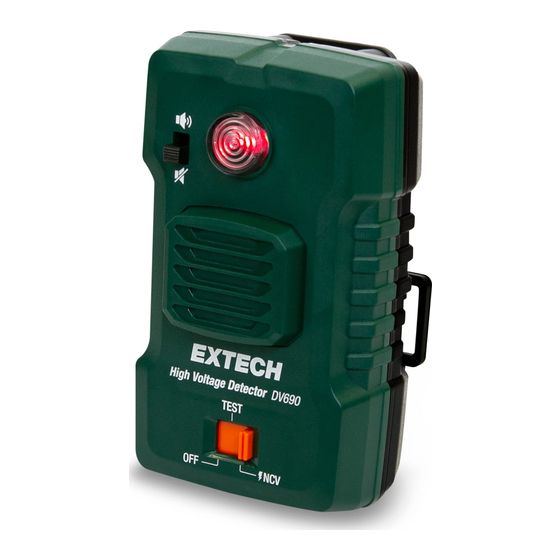
Table of Contents
Advertisement
Quick Links
Advertisement
Table of Contents

Summary of Contents for Extech Instruments DV690
- Page 1 User Manual High Voltage Detector MODEL DV690...
-
Page 2: Table Of Contents
Automatic Self-Test ............. 5 Manual Verification Test ..........5 Ambient Noise Buzzer Test ........... 5 Wearing the DV690 ..............6 Options for Wearing the Detector ........6 Using a ‘Hot Stick’ ...............7 How to Attach the Detector to a Hot Stick......7 Basic Operating Steps ............8... -
Page 3: Introduction
Introduction 1.1 Product Overview The Extech High Voltage Detector, Model DV690, senses the presence of AC voltage and alerts you (audibly and visibly) when you are in close proximity to live equipment and dangerous voltages. The non-contact sensor plate detects radiated electrical fields as it nears a live conductor. -
Page 4: Product Description
Product Description 2.1 Front and Back Descriptions Figure 2.1 Product Description 1. LED alert indicator: Lights when voltage is detected 2. Buzzer mute switch 3. Audible buzzer: Sounds when voltage is detected 4. Function select switch 5. Slots for elastic arm strap or hot stick adaptor 6. -
Page 5: Hot Stick' Attachment Adaptor
Product Description 2.2 ‘Hot Stick’ Attachment Adaptor Figure 2.2 Hot Stick Adaptor Accessories 1. Cylinder 2. Cylinder screw 3. Cylinder bracket 4. Universal spline connector For instructions on assembling the adaptor, connecting it to the detector, and attaching a hot stick, see Section 6, Using a Hot Stick. 2.3 Control Switches 1. -
Page 6: Battery Operation
Battery Operation The DV690 is battery powered and accepts three (3) 1.5 V ‘AA’ alkaline bat- teries in the rear compartment. If the detector does not audibly and visibly alert when you move the function switch to the TEST position, replace the bat- teries and try again. -
Page 7: Product Verification Tests
Product Verification Tests WARNING Before use, please perform all verification procedures, below, to ensure correct and safe operation. Failure to observe this warning can cause severe injury or death. 4.1 Automatic Self-Test 1. Move the selector switch to the TEST position. 2. -
Page 8: Wearing The Dv690
Wearing the DV690 The DV690 can be used by simply holding it in hand, but it may be more con- venient to wear the detector so your hands are free. The detector can be worn around the neck, on an arm, or clipped to an exposed forward facing jacket pocket or belt during operation. -
Page 9: Using A 'Hot Stick
(for example, the Hastings Model HV3357). 6.1 How to Attach the Detector to a Hot Stick Figure 6.1 Attaching the hot stick adaptor to the DV690. Attach the cylinder (1) to the detector by connecting the cylinder bracket (2) to the slots on the back of the detector. -
Page 10: Basic Operating Steps
CAUTION Static electricity can cause the DV690 to trigger; wearing the detector outside of cloth- ing and avoiding contact with the detector will minimize false triggering. 7. When you are finished using the detector, turn the function switch to the OFF position and store it in the supplied carry case. -
Page 11: Distance To Voltage Considerations
Distance To Voltage Considerations The information provided below can help you better understand the behavior of the DV690’s alarms based on the distance you are from a variety of voltage sources. CAUTION This information is intended for general reference only and is not meant to replace proto- cols that you may have in place to ensure safety. - Page 12 Distance To Voltage Considerations Figure 8.1 Distance to Voltage Reference Illustration CAUTION The illustration in Figure 8.1 is presented as a general guideline for reference purposes on- ly. The distances are approximations and the voltages may vary by locale. #NAS100064; r. AA/73965/73965; en-US...
-
Page 13: Specifications
Specifications AC voltage detection range 100 V AC to 69 kV AC Frequency bandwidth 50 to 60 Hz Audible buzzer intensity 106 dB max. (approx.); intensity varies as the detected voltage changes Visual alert Bright red LED with an intensity of 507 Lux Operating temperature 14℉... -
Page 14: Two-Year Warranty
Two-year Warranty FLIR Systems, Inc. warrants this Extech brand instrument to be free of defects in parts and workmanship for two years from date of shipment. To view the full warranty text, see the link below. http://www.extech.com/support/warranties #NAS100064; r. AA/73965/73965; en-US... -
Page 15: Service And Support
Service and Support Customer Support Telephone List: https://support.flir.com/contact Calibration, Repair, and Returns e-mail: repair@extech.com Technical Support: https://support.flir.com #NAS100064; r. AA/73965/73965; en-US... - Page 16 #NAS100064; r. AA/73965/73965; en-US...
- Page 18 User Manual last page Website http://www.flir.com Customer support http://support.flir.com Copyright © 2021, FLIR Systems, Inc. All rights reserved worldwide. Disclaimer Specifications subject to change without further notice. Models and accessories subject to regional market considerations. License procedures may apply. Products described herein may be subject to US Export Regulations.




Need help?
Do you have a question about the DV690 and is the answer not in the manual?
Questions and answers